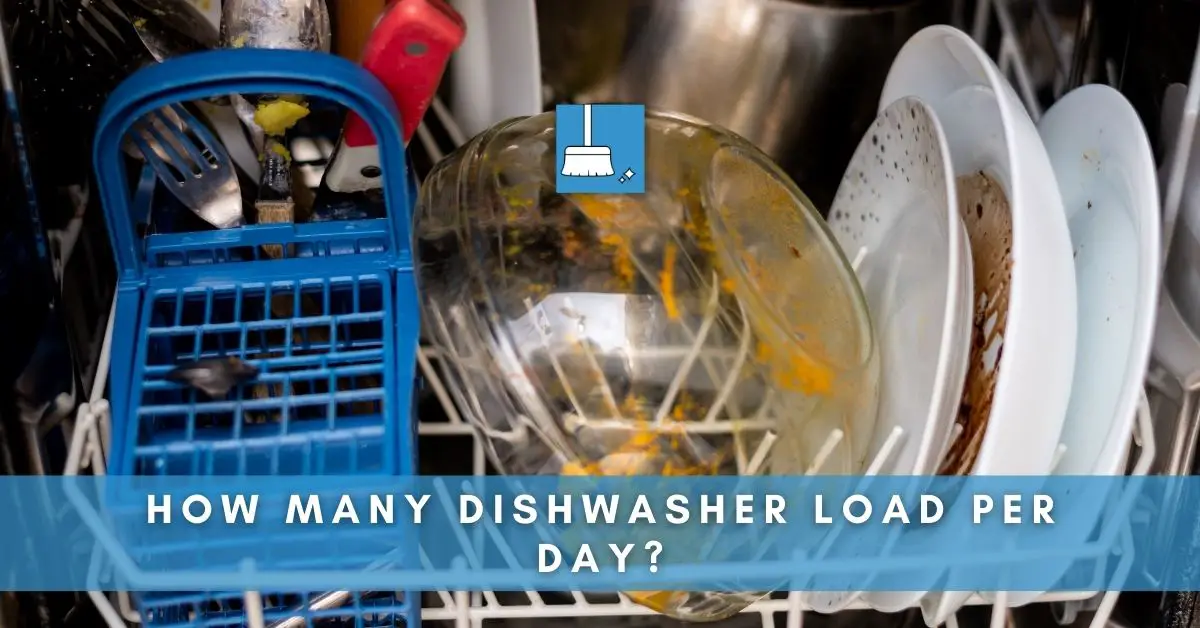Maybe you are one of those people who have a lot of dishes to clean in a day, or maybe you simply want to run your appliances as optimally as you can.
Naturally, you want to know how many times can you load your dishwasher in one day.
This article explains exactly that! We’re also giving the best time to run, cost per load, optimal dish placement, quantity of powder to be used per load, and how to avoid repairs if you’re running your dishwasher too much.
How Many Times Should You Load a Dishwasher Per Day?
Depending on the number of meals in a day, you can run your dishwasher two to three times per day.
To be on the safer side and avoid repairs, consider using your dishwasher less to conserve water, electricity, and other resources. The more you use your dishwasher, the more will it wear leading to early replacement of parts or the dishwasher itself.
However, with the usual load of 2-3 times per day, an average dishwasher runs for 10-12 years.
And remember running your dishwasher every day has a unique advantage; it provides more heat to other appliances in your home.
For instance, your refrigerator needs more heat to keep items cold so you’re getting this done by keeping your dishwasher going.
Best Time of the Day to Run Your Dishwasher!
Your energy company charges you differently based on the load that they experience. Peak hour rates are generally higher.
It is wiser, therefore, to run your dishwasher during non-peak hours.
There’s less energy consumption in the early morning and at night when people are sleeping. These will be good times to run your dishwasher if you want to save on your energy bills.
But be careful! Never run the dishwasher while you are sleeping as it is a fire risk.
Load or Overload?
If you have too many dirty dishes around then you could load your dishwasher twice but don’t overload it.
Overloading the dishwasher when there are too many utensils would only get some utensils stuck or leave damage on some of the dishwares.
Overloading also prevents the spray arms to spray the dishes evenly and may even cause leakages through the front door.
How Full Should Your Dishwasher Be?
You should always try to run a full load. This saves time and resources because your dishwasher will consume the same amount of power regardless of how loaded your dishwasher is.
Work with the racks to optimize load size.
Is It Bad to Run a Dishwasher Half Empty?
It is never bad to load up and start even when the dishwasher isn’t full but for maximizing resource-saving and preventing the dishes from cracking by getting tossed inside.
You might want to allow those dishes to wait for another day.
During this waiting period, scrape off leftovers to avoid the awful stench and leave the door of your dishwasher open.
Of course, you should only do this if you are trying to save resources and prevent breakage but if you need some dishes cleaned urgently or you hate leaving things dirty then go ahead and run it half empty. But don’t make it a habit!
Optimal Dish Placement in a Load!
1- Place your dishes a little apart from each other, fill in the spaces in-between with smaller dishwares (maybe dessert plates, etc.), place your larger items around the perimeter of the rack, and avoid placing knives, wooden utensils, and your spoons.
2- If your dishwasher comes with a spoon rack, make sure the spoons are distanced. For instance: have your spoons face up apart from each other, place your forks facing down for washing.
Placing your utensils together could lead to ‘spooning’ and they come out unclean.
3- For stemware and silverware, use the safety rack where the spray is weak to avoid cracks.
Dishwasher Powder to Use per Load!
Most dishwashers need two to three tablespoons of dishwasher detergent. In case you use dishwasher pods, use only 1 tablet for a load.
The amount of dishwasher powder to be used depends on the load size so check the number of dishes you’re stacking. See that your detergent doesn’t outweigh the load. If you’re running the dishwasher half-empty, use the detergent proportionately. Also, more soiled dishes might require more detergent.
For efficient cleaning, place a little dishwasher powder in the prewash provider if the dishes are too soiled.
You have to try out different kinds of detergents before you are able to decide which is best for you and the machine. On a side note, make sure your detergent is compatible with your dishwasher so it doesn’t get stuck.
Again, do not overfill the dishwasher powder because it will leave residues on your dishes.
Cost of Running Dishwasher Every day!
It takes 25-30 grams of detergent (salt, if you’re using any,) and 4 gallons of water. For an old model, expect close to 9-14 gallons of water.
When it comes to using energy, expect around 1.5 kWh of energy per cycle. (Source) The average kWh rate in the US is 11-14 cents per hour. So that’s about $0.165-0$.21 per load.
For water, we have $1.50 for 1,000 gallons. So that comes to around $0.006 or 0.6 cents per load.
Remember that these prices vary from state to state.
The total cost of running a dishwasher (electricity and water) is approximate $0.171 – $0.216.
Bear in mind that if you run half-cycles, you might be wasting the detergent too.
Dishes Come out Unclean After the Cycle! (What to do?)
If your dishes don’t come out clean, check the drain pipes for larger food items that couldn’t be ground as they got stuck in there.
Another reason why your dishes aren’t coming out clean could be your hot water isn’t hot enough and perhaps the soap dispenser is broken.
Tip: After unloading, check the soap dispenser, if it's still there, it simply means that it hasnt been fully used (water is not properly directed toward it or water isn't hot enough) and your dishes aren't clean enough. If this is the case, check the spray arms for any holes that might be clogged.
Can You Use Cold Water in a Cycle?
Newer models of dishwashers can run on cold water because the machines now have built-in heating elements. Besides, soap detergents have changed from phosphates to enzymes which means now you can use cold water to save energy.
So the old idea of handwashing being better is past tense. With the right detergent pick and an efficient dishwasher, you’ll do just fine with cold water.
What to Do to Avoid Repairs When You Use Your Dishwasher a Lot?
1- Clean Out the Filter: Newer dishwashers don’t come with food grinders as they are noisy. Now, chances are you have some of those leftovers in the drainpipes giving foul odor of fish, the best thing to do once in a while would be to clean the filters regularly.
If you use your dishwasher a lot, you can give the filters some room to breathe by unclogging them more frequently than you would if you used the machine less.
So if you have a peanut butter jar that has the label stuck on it, you’ll have to remove it before placing it to wash. It’ll save your dishwasher in the long run.
2- Clean off Food Residue before Stacking the Dishes In: Scrape off your food before placing the dishes in but do not pre-rinse them because the dish soap is rendered useless if you wash them and it is also a waste of resources.
3- Use Vinegar: Some of us postpone the dishes until the next day but by then, there could be a horrible smell that would develop from the unclean dishes and the dishwasher would start to stink.
In cases like that, use vinegar once in a while to keep your dishwasher fresh every time you open it. Remember not to overuse it because it’s an acid and could lead to the discoloration of your dishes or damage your dishwasher.
The time it Takes! (Normal vs Heavy)
On a normal cycle, expect your dishwasher to run from 1.5 to 2 hours but of course, this depends on how grimy your dishes are and the cycle you place it on.
For heavy loads (usually called a heavy cycle or pots and pans cycle), it could run up to 4 hours depending on the cycle and if you scraped off the gunk from the dish before washing it. This cycle uses extra water and hotter water (so more heating is required).
Is It Cheaper to Run the Dishwasher than Washing by Hand?
According to statistics, an average flow rate from the sink when washing takes 50 gallons and that’s if you are mindful, if you aren’t, the expectation is about 70 gallons of water.
Dishwashers save water as the newer models use around 4 gallons of water.
Although energy isn’t calculated when washing by hand but it requires effort to save water so while hand washing saves energy, the dishwasher saves water but with the new models which can be used with cold water, you can save time, soap, and energy but remember with an average dishwasher, you could still be using close to 1.5 kWh of energy per cycle.
As much as this is water versus energy, rather than hand washing a dish for fifteen seconds, you could do something else so in the long run, dishwashing is still cheaper when you invest in a good machine.
Conclusion!
You can load your dishwasher 2-3 times daily. Just make sure it’s full and placed correctly so your dishes come out fresh and clean.
However, the best way to keep using your dishwasher without repairs is to limit the number of times you run it per day or in a week.






Pingback: Are Dishwasher Tablets Flammable? (5 Causes Of Fire) »